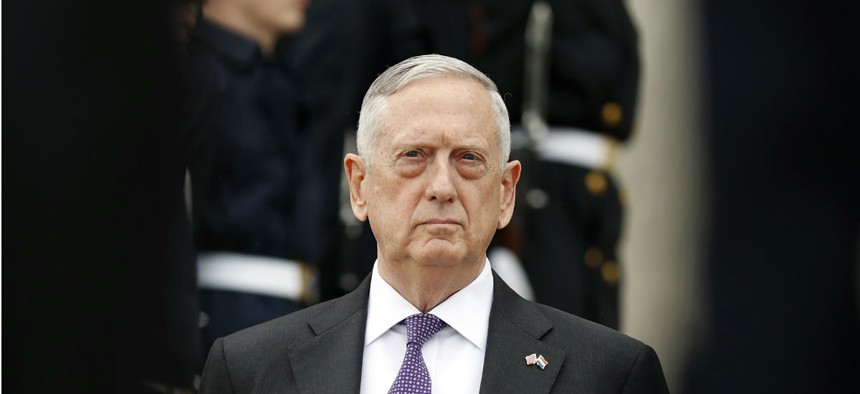
Defense Secretary James Mattis at the Pentagon in August. Alex Brandon/AP
What Great Leadership Looks Like
Lessons from watching Defense Secretary James Mattis in action.
In 2017, it can be difficult to find examples of great leadership. Today, though, I want to offer two of them.
The first is of neighbors, volunteers, first responders, law enforcement, the National Guard and the U.S. Coast Guard pulling together to rescue each other in the greater Houston area. Because of the scope of the storm and torrential rains that came with Hurricane Harvey, government authorities quickly became overwhelmed with the scale of the rescue effort. Fortunately, thousands of people are showing personal leadership, courage and compassion and stepping in to fill the gap. (You can help Houston and the Gulf Coast by donating to any of these organizations.)
The stories are remarkable. One that stuck with me was from a CNN reporter who was riding along with a crew of civilians in an airboat that had traveled from three hours away to come rescue people from the flooding. The reporter did a live interview with a family of four that the boat had just rescued from the roof of a car where they had been stranded for two days. They had lost everything they own but were beside themselves with gratitude for their rescuers and with joy in being alive. It was such a great example of putting into action the values upon which the United States of America is based. The stories of need and the response to those needs should remind all of us of what unites rather than divides us.
The second example is another model of American values in action. It’s demonstrated by Secretary of Defense James Mattis in this video shot by a soldier on his smartphone while Mattis was visiting a forward U.S. base somewhere in the Middle East. I encourage you to watch the video. I’m not ashamed to admit that I choked up when I watched it. It feels so rare these days to see sincere and authentic leadership in action that my emotions were stirred by the Mattis video. Here are some of the leadership traits that moved me:
Stopping: At the beginning of the video, Mattis is walking down a dusty gravel road in his business suit with a couple of officers in fatigues on either side of him. As the video rolls, you can hear the excitement in the troops’ voices: “Oh yeah! Mad Dog! Come on over here sir!” Mattis laughs, stops and says he’s been ambushed.
Readiness: It’s striking how easily Mattis started giving his talk as the troops gathered around him. More remarkable is that while his remarks were spontaneous, he clearly knew what he wanted to say and why he wanted to say it. He immediately offered his thanks and noted the sacrifice that these folks were making while far away from home.
Mission Orientation: He tells them, “the only way this experiment we call America is going to survive is because of tough hombres like you” and reminds them that “we don’t frickin’ scare.”
Truth-telling: “You’re a great example for our country right now. We’ve got some problems. You know it and I know it.” He then encourages them to “hold the line” until Americans get back to understanding and respecting and being friendly to each other. “We owe it to each other because we’re so doggone lucky to be Americans.”
Appreciation: Mattis, who had retired as a four-star general before taking his current post, told the group “the only reason I came back is to serve alongside young people like you who are so selfless and, frankly, so rambunctious.” By doing this, Mattis personalizes their mission and connects himself to it. He is one of them.
Love: At one point, Mattis addresses the group as “my fine young soldiers, sailors, airmen, Marines.” You can hear the love and pride in his voice as he does. The great leaders literally love the people they lead.
That video got posted on a Facebook page where military personnel share their insider views with each other. How many tens of thousands of servicemen and women do you think have seen that three-minute pep talk from Mattis by now? How do you think they feel about their leader? That’s a whole lot of leverage from a spontaneous three-minute talk. It works because it came from the heart.
NEXT STORY: Six Ways To Be a More Approachable Leader







